Helena Fourment
Helena (or Hélène) Fourment (11 April 1614 – 15 July 1673) was the second wife of Baroque painter Peter Paul Rubens. She was the subject of a few portraits by Rubens, and also modeled for other religious and mythological paintings.
Helena Fourment | |
|---|---|
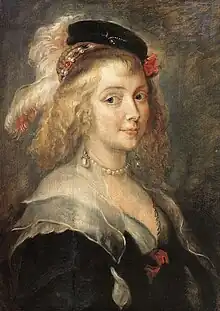 Helena Fourment, c. 1630, by Jan Boeckhorst | |
| Born | 11 April 1614 Antwerp, Belgium |
| Died | 15 July 1673 (aged 59) Brussels, Belgium |
| Nationality | Flemish |
| Other names | Hélène Fourment |
| Spouses | |
| Children | 11, including Jean and Hyacinthe-Marie |
| Relatives |
|
Family
Helena Fourment was the youngest child of Daniël I Fourment, a wealthy Antwerp silk and tapestry merchant, and Clara Stappaerts. After his death, Daniel left to his son (Daniel II) an important collection of tapestries of Oudenaarde, Brussels, and Antwerp and 35 paintings of his son-in-law, a large painting of Jordaens and several works of Italian masters.[1] They had four sons and seven daughters. Helena Fourment was buried together with her first husband, children and parents in the Saint James' church, Antwerp. Most of her sisters married into important families.
Daniel I Fourment, died 1643 : marr. Clara Stappaerts.[2]
- Peeter Fourment, born 1590:
Married to Antonia van Hecke. - Daniel II Fourment, Lord of Wijtvliet, born 1592:
married to Clara Brant, sister of Isabella Brant (1591–1626). - Clara Fourment, (1593-1643):
married to Peter van Hecke (1591–1645), tapestry dealer. - Joanna Fourment, born 1596:
married to Balthasar-Nicolaas de Groot. - Susanna Fourment (1599–1628):
married to Arnold Lunden, both painted by Rubens.[3] - Marie Fourment, born 1601:
married to Henri Moens. - Catharina Fourment, born 1603:
married to Peeter Hannecaert, Alderman. - Joannes Fourment, born 1609:
married to Marie Volpi. - James Fourment, born 1611.
- Elisabeth Fourment (1609–1667):
married 23 October 1627 to Nicolas Pycqueri, died 1661: almoner of Antwerp.[4] - Helena Fourment (1614–1673):
married to 1st Peter Paul Rubens, 2nd the 1st count of Bergeyck.
- Peeter Fourment, born 1590:
First marriage
Helena Fourment married Rubens on 6 December 1630 in Saint James,[5] when she was 16 years old and he was aged 53. His first wife, Isabella Brant, had died in 1626. Helena's brother Daniël Fourment the younger was married to Clara Brant, the sister of Isabella. Daniël Fourment the elder was an art lover and possessed works by Rubens and Jacob Jordaens, and works by Italian masters; he also commissioned from Rubens a series of tapestries depicting the life of Achilles.[6]
Peter Paul Rubens, marr. 2nd to Helena Fourment:
- Clara-Joanna Rubens, baptized 18 January 1632: marr. Philips van Parys, knight
- François I Rubens, bapt. 12 July 1633: alderman of Antwerp in 1659, marr. Susanna-Gratiana Charles.
- Isabella-Helena Rubens, baptized 3 May 1635
- Peter III Paul Rubens, baptized 1 March 1637: ordained priest.
- Constantia-Albertina Rubens, baptized 3 February 1641: entered La Cambre Abbey in 1668.
Second marriage
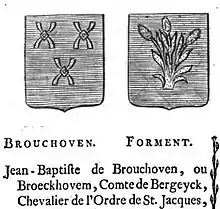
After the death of Rubens, Helena started a relationship with Jean-Baptiste de Brouchoven, assessor and alderman of Antwerp, who later became 1st Count of Bergeyk.[7] On 9 October 1644 their first son Jean de Brouchoven, 2nd Count of Bergeyck, was born, and Helena and Jean-Baptist married in 1645. Her second husband, who was a military knight of St-Iago, outlived her and died during a diplomatic mission in Toulouse in 1681.[8]
Jean-Baptist de Brouchoven, 1st count of Bergeyck; married to Helena Fourment[9]
- Jean de Brouchoven, 2nd Count of Bergeyck, (1644–1725), later created 1st Baron of Leefdael:
married to Livina Marie de Beer-Meulebeke.- Nicolas-Joseph de Brouchoven, 3rd Count of Bergeyck, 2nd Baron of Leefdael: (descendants upon today).
- Hyacinthe-Marie de Brouchoven, Lord of Spy (1650–1707): 19th President of the Great Council;
married to Marie-Adrienne Zuallart.- Guillaume-François de Brouchoven, Lord of Spy: dies without heirs.
- Nicolas de Brouchoven, Lord of Attevoorde:
married to Marie-Isabelle de Pommereaux, Lady of Hove- Henri de Brouchove, Lord of Hove
- Catherine de Brouchoven':
married to Gilles de Paepe, Lord of Glabbeecq, son of Léon-Jean de Paepe. - Marie-Fernandine de Brouchoven: entered a Carmelite convent.
- Hélène-Isabelle de Brouchoven'; married Emmanuel-Joseph, Marquess of Villa-Flores
- Jean de Brouchoven, 2nd Count of Bergeyck, (1644–1725), later created 1st Baron of Leefdael:
Helena died in Brussels in 1673 aged 59. Amongst the many descendants of her grandson the 3rd Count of Bergeyck we find Louis de Brouchoven de Bergeyck and his great-granddaughter Stéphanie, Hereditary Grand Duchess of Luxembourg.
Presence
Helena Fourment was said to be very beautiful, amongst others by the Cardinal-Infante Ferdinand of Austria, then Governor of the Netherlands, stating that she was "undoubtedly the most beautiful one may see here",[10] and by the poet Gaspar Gevartius, a friend of Rubens, who praised "Helen of Antwerp, who far surpasses Helen of Troy".[11]
Paintings
Portraits
_-_Alte_Pinakothek_-_Munich_-_Germany_2017.jpg.webp) Helena Fourment, c. 1630, now in the Alte Pinakothek
Helena Fourment, c. 1630, now in the Alte Pinakothek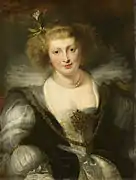 Helena Fourment in wedding dress, detail
Helena Fourment in wedding dress, detail_-_(2).JPG.webp) Helena Fourment with two of her children, c. 1635, Louvre
Helena Fourment with two of her children, c. 1635, Louvre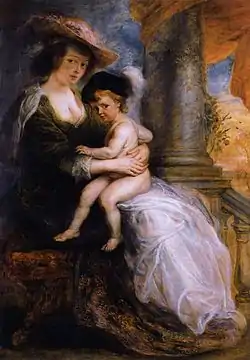 Helena Fourment with her Son Francis, c. 1634-1635, Alte Pinakothek
Helena Fourment with her Son Francis, c. 1634-1635, Alte Pinakothek Portrait of Helena Fourment, c. 1638, now in the Museu Calouste Gulbenkian
Portrait of Helena Fourment, c. 1638, now in the Museu Calouste Gulbenkian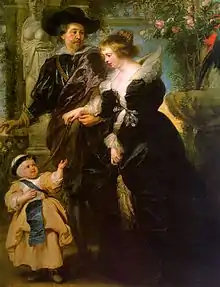 Rubens with Helena Fourment and their son Peter Paul, 1639, now in the Metropolitan Museum of Art
Rubens with Helena Fourment and their son Peter Paul, 1639, now in the Metropolitan Museum of Art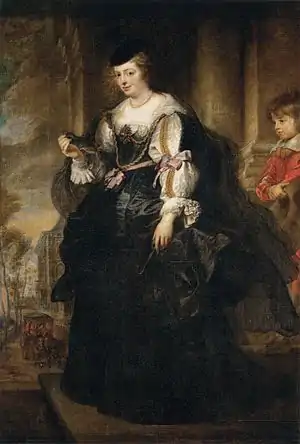 Helena Fourment with a Carriage, 1639
Helena Fourment with a Carriage, 1639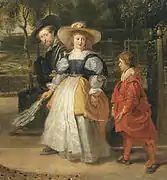 Helena Fourment with her first husband and child
Helena Fourment with her first husband and child
- Helena Fourment in wedding dress, Munich, Alte Pinakothek, 1630-1631; a studio copy of this work is in the collection of the Rijksmuseum
- Pörtrait of Helena Fourment with a glove", Munich, Alte Pinakothek (same as above?)
- Helena Fourment with her eldest son, Frans, 1635, Munich, Alte Pinakothek
- Rubens and Helena Fourment walking in their garden, Munich
- Helena Fourment with her children Clara, Johanna, and Frans, 1636-1637, Louvre
- Helena Fourment and Frans Rubens, Louvre
- Rubens, his wife Helena Fourment, and their son Peter Paul, c. 1639, Metropolitan Museum of Art
- Portrait of Helena Fourment(?) a studio work in the collection of the Royal Museum of Fine Arts in Brussels
- Portrait of Helena Fourment(?) a 17th-century work from Antwerp, now in the Rubenshuis
Model
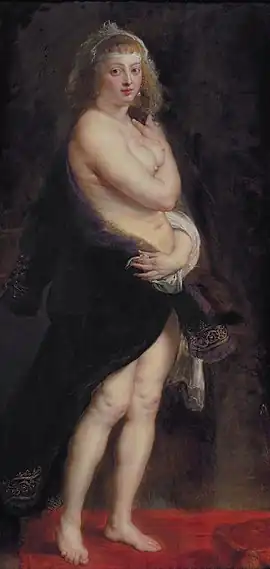
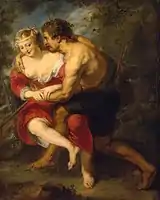 Pastoral Scene
Pastoral Scene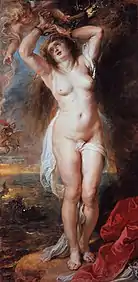
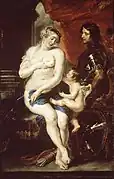 Venus, Mars and Cupid
Venus, Mars and Cupid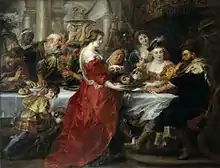 The feast of Herodes and Salome
The feast of Herodes and Salome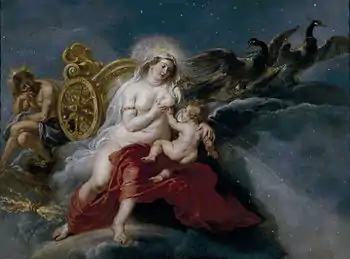
 Judgment of Paris
Judgment of Paris
_-_WGA20317.jpg.webp) Feast of Venus (detail)
Feast of Venus (detail)
- Judgment of Paris, Museo del Prado (the Venus-figure is modelled on Helena Fourment)
- The Garden of Love, Prado, 1630–1633
- Het Pelsken, 1638, Kunsthistorisches Museum, Vienna
- The Origin of the Milky Way, c. 1637
Siblings: Clara van Hecke née Fourment, and Susanna Lunden née Fourment
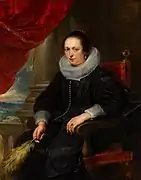 Portrait of a woman, possibly Clara Fourment, c. 1630, now in the Mauritshuis
Portrait of a woman, possibly Clara Fourment, c. 1630, now in the Mauritshuis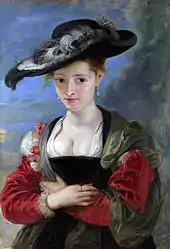 The Felt Hat, probably a portrait of Susanna Fourment, c. 1622, now in the National Gallery
The Felt Hat, probably a portrait of Susanna Fourment, c. 1622, now in the National Gallery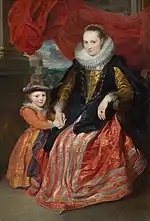 Susanna Fourment and her daughter, 1621, by Anthony Van Dyck, in the National Gallery of Art
Susanna Fourment and her daughter, 1621, by Anthony Van Dyck, in the National Gallery of Art
Notes
- De Vlaemsche school: tijdschrift voor kunsten, letteren en wetenschappen, Volume 9:p. 142
- De Vlaemsche school: tijdschrift voor kunsten, letteren en wetenschappen, Volume 9:p. 142
- Fahy, Everett (1973). The Wrightsman Collection. 5. Paintings, drawings. Metropolitan Museum of Art. p. 196. ISBN 9780870990120.
- Notice des oeuvres d'art de l'eglise paroissaile ... de St. Jacques a ...
- De Vlaemsche school: tijdschrift voor kunsten, letteren en wetenschappen, Volume 9:p. 142
- Campbell, Thomas Patrick (2010). Tapestry in the Baroque. Metropolitan Museum of Art. p. 28. ISBN 9780300155143.
- Knackfuss, H. (1904). Rubens. p. 158. ISBN 9783954910489.
- Biographie universelle, Bon - Bru, Volume 5
- Jean Charles Joseph de Vegiano, Nobiliaire des Pays-Bas et du Comté de Bourgogne
- Liedtke, Walter A. (1984). Flemish paintings in the Metropolitan Museum of Art. Metropolitan Museum of Art. p. 177. ISBN 9780870993565.
- Néret, Gilles (2004). "The Most Beautiful Woman in Antwerp". Peter Paul Rubens, 1577-1640. Taschen. ISBN 9783822828854.
Further reading
- Brendel, Maria L. (2011). Die Macht der Frau. Rubens' letztes Modell Helene Fourment (in German). Berlin: Parthas. ISBN 978-3-86964-037-2.
- Liedtke, Walter A. (1984). Flemish paintings in the Metropolitan Museum of Art. New York: The Metropolitan Museum of Art. ISBN 0870993569. (see index, v.1; Lunden, Susanna (née Fourment) for information about her daughter)
External links
 Media related to Hélène Fourment at Wikimedia Commons
Media related to Hélène Fourment at Wikimedia Commons